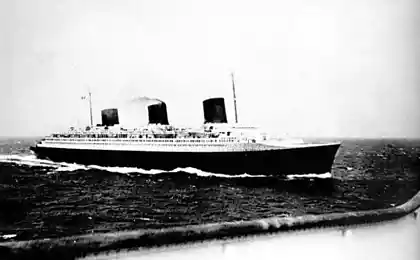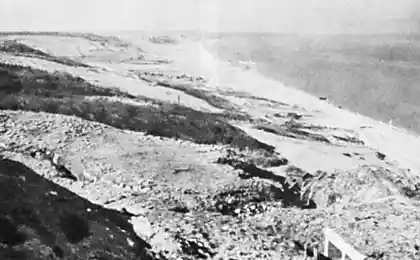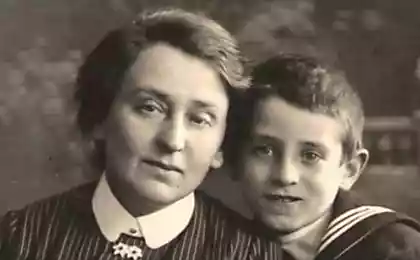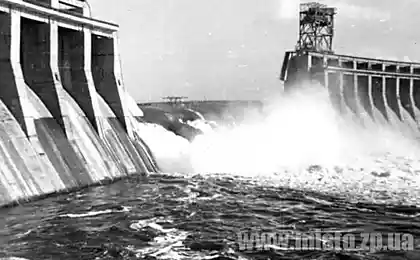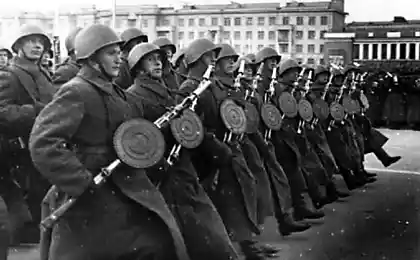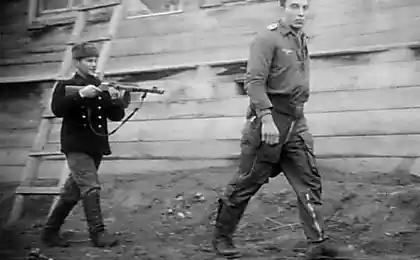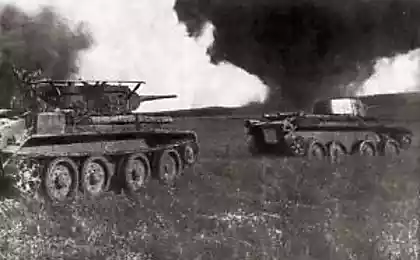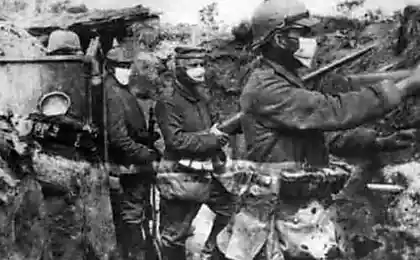703
What did the Germans on the eve of the Normandy landings?
June 6, the anniversary of the Normandy operation ("Operation Overlord»).
Read, read about it, I came across an interesting post.
8 photos + text
source

Event Reminder:
Normandy operation or the operation "Overlord" - Allies strategic operation of the landing of troops in Normandy (France), which began early in the morning of June 6 1944 and ended August 31, 1944, after which the Allies crossed the River Seine, Paris was released and went on the offensive to the French- German border.
The operation opened the West (or t. N. "Second") front in Europe in World War II. Until now, the largest amphibious operation in history - it was attended by more than 3 million people who have crossed the English Channel from England to Normandy.
Norman operation was carried out in two stages:
"Operation Neptune" - the code name of the initial phase of "Overlord" - began June 6, 1944 (the date is also known as "D-Day"), ended July 1, 1944. Her goal was to gain foothold in the continent, which lasted until July 25;
Operation "Cobra" - and a breakthrough offensive in France was carried out allies immediately after the first phase.
Excerpts from "stratagem of World War II» (Stratagèmes de la seconde guerre mondiale)
February 14, 1944 was a landmark event for the German organizational structure: the Abwehr (military intelligence and counterintelligence) came under the control of Reich Security Main Office, ie intelligence and counterintelligence Nazis. Admiral Canaris was dismissed from his post, and in July he was detained on suspicion of involvement in a plot to offset Hitler. This merger is certainly angered many people and brought confusion in the German intelligence services, which are already entangled in a stream of disinformation allies. Incoming information to them were so contradictory that the German military leaders were confused. Chief of Staff von Rundstedt (commander in chief of the army group «D») General Blyumentritt commented on the situation: "We receive very little reliable information and vague reports from the zones of concentration of British and American forces in the south of England. We had a small number of German agents who reported to us on the radio about what they saw, but they were unable to find anything substantial, and none of the information received did not give precise instructions about the landing. "
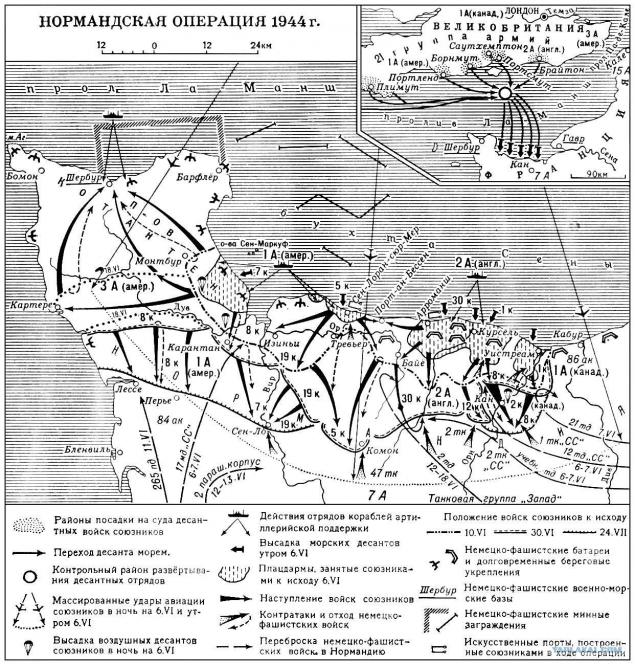
Blyumentrittu was not known, that his agents in the United Kingdom were under the supervision of the Committee of the XX. In the period from May 1 to June 6, 1944 Kriegsmarine received a total of 173 reports with intelligence about the "invasion" of allies. They assert the following:
- The landing will happen somewhere between the Somme and Belgium during the period from 10 to 21 May;
- Landing would not be until July and August;
- Allied landing is scheduled for mid-May;
- A report of 16 May: landing is scheduled for the 20th day in Cherbourg;
- The landing of allied forces will occur May 19 and 20 after the airborne troops in the north of France;
- The landing of the Allies begins with Denmark, no later than 15 June;
- Allied landing was postponed due to the strengthening of the German fortifications on the coast;
- The landing is scheduled for the period from 21 May to 20 June;
- The landing will happen in the summer, as follows: a diversion on the left wing in Denmark, one on the right wing in Belgium, the main blow is aimed at Hamburg;
- The landing postponed for the fall because of the limited capacity of the Union aviation;
- The landing on the night of 22 of August 23, during low tide;
- In the near future will not be landing.
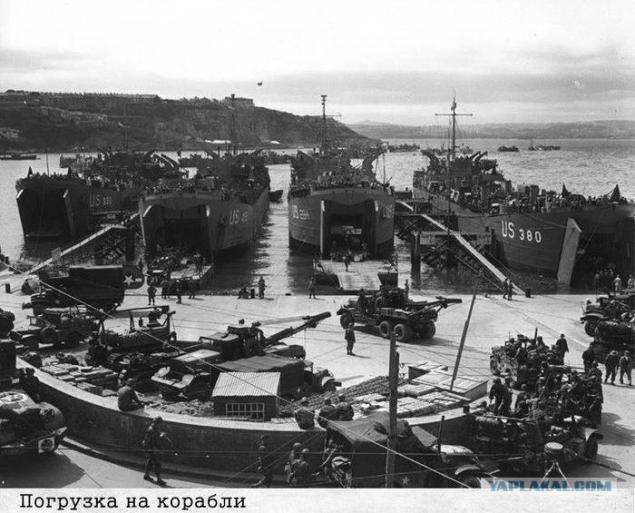
It is easy to understand the confusion of the German secret services in the form of the flow of contradictory information from experienced agents ... who were actually members of the Committee of the XX.
OKW accused Krigsmarine that he could not find out anything about the preparation of the operation allies. As a result, he had received a detailed analysis of 173 reports. As there were only seven copies of the confidential report such findings were made:
- 102 were completely false (59%);
- Seven were too inaccurate (4%);
- 26 contained possible, but not verifiable information (15%);
- 24 partially contained accurate information that could confirm ... only upon landing (14%);
- 14 were accurate, but it was announced after the landing (8%).
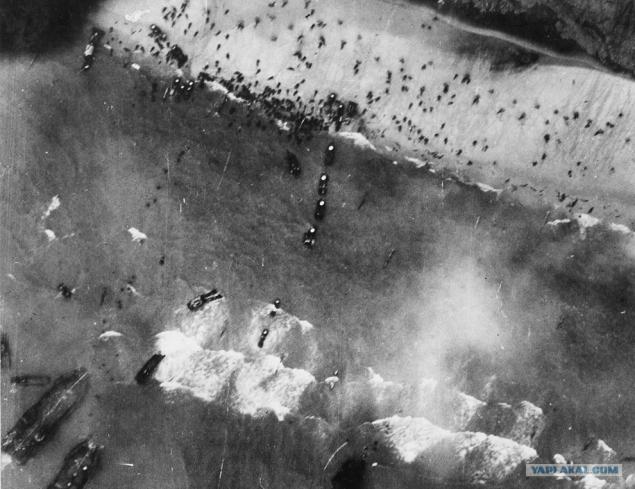
In one of the reports it reported the exact landing site, but it has come June 6th. The source of all intelligence was the Committee of the XX. The last true report also sent an agent of the Committee: thus he intended to maintain the confidence of the Germans to again mislead them after June 6. March 23, 1945 Chief of the Kriegsmarine sent to the OKW report read: "We have to assume that an increasing number of informants are actually double agents that transmit us the fabricated enemy intelligence." "The enemy closely followed the secrecy and the element of surprise during the preparation and the landing," - the document says.
The report was the recognition of the effectiveness of disinformation strategy, which managed to hide from the Germans and force them not to pay attention to what seems to be impossible to hide, at least with the approaching date of landing: Intensifying bombing and Relief of resistance groups, strengthening the air defense at the south coast of England, the adoption of measures against the travel of foreign diplomats and the gap of communication channels with their capitals, expanding the radio ... In the German Navy knew that unlike the rest of the coast of the allies did not undermining the mouth of the Seine. However, all these facts have sunk into such a powerful stream of false reports that German secret services were not able to separate the truth from the lies. Disinformation operation Bodyguard and Fortitude clouded eyes of German spies and drew their attention to the Pas-de-Calais.

May 23, 1944 German armed forces included:
- 39 divisions for various purposes, and 25 armored divisions in the USSR;
- 43 divisions for different purposes and 9 armored divisions in Italy and the Balkans;
- 76 divisions for different purposes and the 1st Tank Corps in Western Europe (the Netherlands, Denmark, Norway, Belgium and France).
June 5, the day before landing in France were 59 German divisions, and only seven of them on the territory of Normandy (four positions).
Germans succumbed to misinformation and greatly overestimated the strength of the allied forces in the UK. May 30, 1944 Intelligence managed to intercept aimed Tokyo report on the meeting with Hitler, the Japanese Ambassador Oshima. As noted in the document, the Führer was convinced that at the disposal of the Allies in the UK there are 80 to 90 divisions, and that, despite possible diversions in Norway and Normandy, the main focus was supposed to be hitting the Pas de Calais.
Opinion about Hitler enemy forces based on the analysis of the German secret services, who agreed on the probability of the presence of the Allies 80 divisions. In fact, there were only 47. disinformation operation was crowned with great success. German Marshals von Rundstedt and Rommel were confused. Von Rundstedt was convinced that the Allied landing occurs at the narrowest point of the English Channel, that is, in the Pas-de-Calais. And until the end she did not change his views. Rommel was of the same opinion, but "just in case" found it necessary to accelerate the preparation of defensive structures on the beaches of Normandy. "The invasion will not happen until August," - he said the Chief of Staff of the 352 th Division at the end of May 1944. Thus, he did not disperse forces XV army, which at that time was in the Pas-de-Calais.
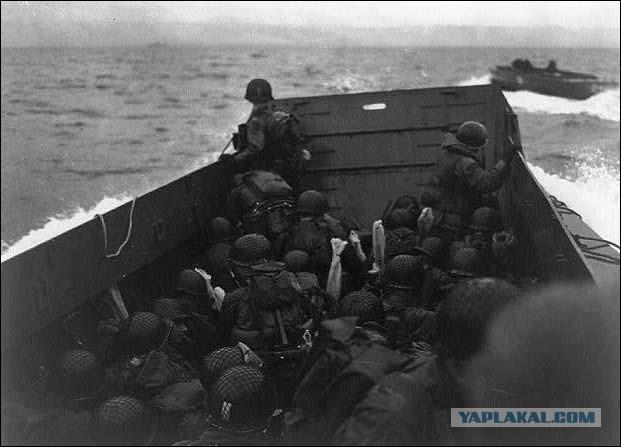
Hitler occasionally still had doubts. At some point, his attention riveted the Cherbourg. He was convinced that the Allies want to seize the port, but generally stuck to the old opinion: "The main forces landed in Pas-de-Calais ... landing elsewhere is just a red herring." June 1, 1944 in the General Staff of Army XV in Tourcoing operators wiretapping noted in the BBC broadcast a personal message: "The long wail of violins of autumn ...» XV was alerted ... Because this signal, which became known to the Germans in 1943 , intended for subversive groups in the north of the Seine and served the order to begin sabotage. But that's no units actually something was not ... At the headquarters of XV Army was also known that the second part of the message would mean 24-hour readiness for surgery ... unless, of course, it will not be canceled at the last moment, as it has been several times . In addition, once warned saboteurs, so the landing was to be held in the area of Army XV.
The evening of 5 June, a large Part XV of the army was still in the north of the Seine. In Normandy, the same was only one armored division. Von Rundstedt sent to the OKW the following report: "In preparation for the Allied offensive there has been significant progress. Evaluation bombed sites suggests that an attack will occur somewhere in the area between the Scheldt and Normandy or Brittany. The bombing of the coastal fortifications between Dunkirk and Dieppe, the bridges on the Seine and Oise, and the road between Rouen and Paris indicate widespread landing. However, for its implementation in the near future, it does not indicate ".
Jean Dev, former head of the intelligence service of the French forces in Laos (1949-1953) and Director of the National Police of Laos, a political adviser to Prime Minister on National Security.
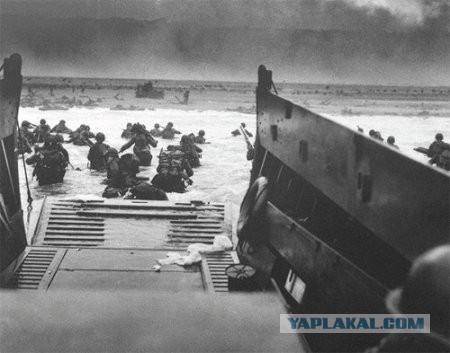
That's so.
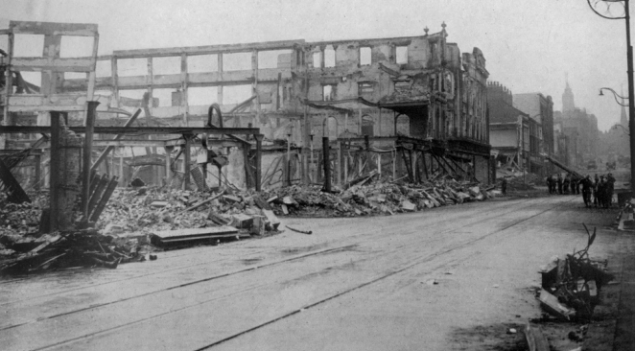
Source:
Read, read about it, I came across an interesting post.
8 photos + text
source

Event Reminder:
Normandy operation or the operation "Overlord" - Allies strategic operation of the landing of troops in Normandy (France), which began early in the morning of June 6 1944 and ended August 31, 1944, after which the Allies crossed the River Seine, Paris was released and went on the offensive to the French- German border.
The operation opened the West (or t. N. "Second") front in Europe in World War II. Until now, the largest amphibious operation in history - it was attended by more than 3 million people who have crossed the English Channel from England to Normandy.
Norman operation was carried out in two stages:
"Operation Neptune" - the code name of the initial phase of "Overlord" - began June 6, 1944 (the date is also known as "D-Day"), ended July 1, 1944. Her goal was to gain foothold in the continent, which lasted until July 25;
Operation "Cobra" - and a breakthrough offensive in France was carried out allies immediately after the first phase.
Excerpts from "stratagem of World War II» (Stratagèmes de la seconde guerre mondiale)
February 14, 1944 was a landmark event for the German organizational structure: the Abwehr (military intelligence and counterintelligence) came under the control of Reich Security Main Office, ie intelligence and counterintelligence Nazis. Admiral Canaris was dismissed from his post, and in July he was detained on suspicion of involvement in a plot to offset Hitler. This merger is certainly angered many people and brought confusion in the German intelligence services, which are already entangled in a stream of disinformation allies. Incoming information to them were so contradictory that the German military leaders were confused. Chief of Staff von Rundstedt (commander in chief of the army group «D») General Blyumentritt commented on the situation: "We receive very little reliable information and vague reports from the zones of concentration of British and American forces in the south of England. We had a small number of German agents who reported to us on the radio about what they saw, but they were unable to find anything substantial, and none of the information received did not give precise instructions about the landing. "

Blyumentrittu was not known, that his agents in the United Kingdom were under the supervision of the Committee of the XX. In the period from May 1 to June 6, 1944 Kriegsmarine received a total of 173 reports with intelligence about the "invasion" of allies. They assert the following:
- The landing will happen somewhere between the Somme and Belgium during the period from 10 to 21 May;
- Landing would not be until July and August;
- Allied landing is scheduled for mid-May;
- A report of 16 May: landing is scheduled for the 20th day in Cherbourg;
- The landing of allied forces will occur May 19 and 20 after the airborne troops in the north of France;
- The landing of the Allies begins with Denmark, no later than 15 June;
- Allied landing was postponed due to the strengthening of the German fortifications on the coast;
- The landing is scheduled for the period from 21 May to 20 June;
- The landing will happen in the summer, as follows: a diversion on the left wing in Denmark, one on the right wing in Belgium, the main blow is aimed at Hamburg;
- The landing postponed for the fall because of the limited capacity of the Union aviation;
- The landing on the night of 22 of August 23, during low tide;
- In the near future will not be landing.

It is easy to understand the confusion of the German secret services in the form of the flow of contradictory information from experienced agents ... who were actually members of the Committee of the XX.
OKW accused Krigsmarine that he could not find out anything about the preparation of the operation allies. As a result, he had received a detailed analysis of 173 reports. As there were only seven copies of the confidential report such findings were made:
- 102 were completely false (59%);
- Seven were too inaccurate (4%);
- 26 contained possible, but not verifiable information (15%);
- 24 partially contained accurate information that could confirm ... only upon landing (14%);
- 14 were accurate, but it was announced after the landing (8%).

In one of the reports it reported the exact landing site, but it has come June 6th. The source of all intelligence was the Committee of the XX. The last true report also sent an agent of the Committee: thus he intended to maintain the confidence of the Germans to again mislead them after June 6. March 23, 1945 Chief of the Kriegsmarine sent to the OKW report read: "We have to assume that an increasing number of informants are actually double agents that transmit us the fabricated enemy intelligence." "The enemy closely followed the secrecy and the element of surprise during the preparation and the landing," - the document says.
The report was the recognition of the effectiveness of disinformation strategy, which managed to hide from the Germans and force them not to pay attention to what seems to be impossible to hide, at least with the approaching date of landing: Intensifying bombing and Relief of resistance groups, strengthening the air defense at the south coast of England, the adoption of measures against the travel of foreign diplomats and the gap of communication channels with their capitals, expanding the radio ... In the German Navy knew that unlike the rest of the coast of the allies did not undermining the mouth of the Seine. However, all these facts have sunk into such a powerful stream of false reports that German secret services were not able to separate the truth from the lies. Disinformation operation Bodyguard and Fortitude clouded eyes of German spies and drew their attention to the Pas-de-Calais.

May 23, 1944 German armed forces included:
- 39 divisions for various purposes, and 25 armored divisions in the USSR;
- 43 divisions for different purposes and 9 armored divisions in Italy and the Balkans;
- 76 divisions for different purposes and the 1st Tank Corps in Western Europe (the Netherlands, Denmark, Norway, Belgium and France).
June 5, the day before landing in France were 59 German divisions, and only seven of them on the territory of Normandy (four positions).
Germans succumbed to misinformation and greatly overestimated the strength of the allied forces in the UK. May 30, 1944 Intelligence managed to intercept aimed Tokyo report on the meeting with Hitler, the Japanese Ambassador Oshima. As noted in the document, the Führer was convinced that at the disposal of the Allies in the UK there are 80 to 90 divisions, and that, despite possible diversions in Norway and Normandy, the main focus was supposed to be hitting the Pas de Calais.
Opinion about Hitler enemy forces based on the analysis of the German secret services, who agreed on the probability of the presence of the Allies 80 divisions. In fact, there were only 47. disinformation operation was crowned with great success. German Marshals von Rundstedt and Rommel were confused. Von Rundstedt was convinced that the Allied landing occurs at the narrowest point of the English Channel, that is, in the Pas-de-Calais. And until the end she did not change his views. Rommel was of the same opinion, but "just in case" found it necessary to accelerate the preparation of defensive structures on the beaches of Normandy. "The invasion will not happen until August," - he said the Chief of Staff of the 352 th Division at the end of May 1944. Thus, he did not disperse forces XV army, which at that time was in the Pas-de-Calais.

Hitler occasionally still had doubts. At some point, his attention riveted the Cherbourg. He was convinced that the Allies want to seize the port, but generally stuck to the old opinion: "The main forces landed in Pas-de-Calais ... landing elsewhere is just a red herring." June 1, 1944 in the General Staff of Army XV in Tourcoing operators wiretapping noted in the BBC broadcast a personal message: "The long wail of violins of autumn ...» XV was alerted ... Because this signal, which became known to the Germans in 1943 , intended for subversive groups in the north of the Seine and served the order to begin sabotage. But that's no units actually something was not ... At the headquarters of XV Army was also known that the second part of the message would mean 24-hour readiness for surgery ... unless, of course, it will not be canceled at the last moment, as it has been several times . In addition, once warned saboteurs, so the landing was to be held in the area of Army XV.
The evening of 5 June, a large Part XV of the army was still in the north of the Seine. In Normandy, the same was only one armored division. Von Rundstedt sent to the OKW the following report: "In preparation for the Allied offensive there has been significant progress. Evaluation bombed sites suggests that an attack will occur somewhere in the area between the Scheldt and Normandy or Brittany. The bombing of the coastal fortifications between Dunkirk and Dieppe, the bridges on the Seine and Oise, and the road between Rouen and Paris indicate widespread landing. However, for its implementation in the near future, it does not indicate ".
Jean Dev, former head of the intelligence service of the French forces in Laos (1949-1953) and Director of the National Police of Laos, a political adviser to Prime Minister on National Security.

That's so.

Source:



